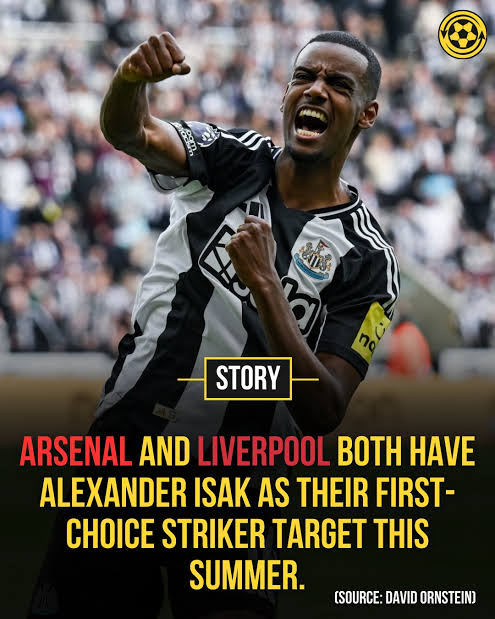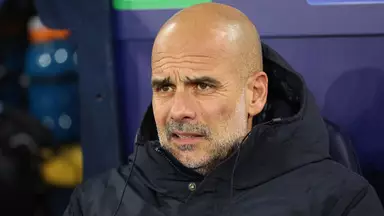Arsenal’s £150m Transfer Dilemma: The Alexander Isak Question

The summer transfer window of 2025 has presented Arsenal with one of their most significant strategic decisions in recent years. As Liverpool’s British transfer record-shattering bid for Newcastle United’s Alexander Isak sends shockwaves through the Premier League, Arsenal finds themselves at a crossroads that could define their attacking approach for years to come. The Swedish striker’s astronomical valuation has forced Mikel Arteta and sporting director Andrea Berta to make a calculated gamble that could either prove genius or leave them wondering “what if.”
Alexander Isak’s situation has evolved from summer speculation to genuine transfer drama in the final month of the window. The 25-year-old Swedish international, who has established himself as one of Europe’s most clinical finishers, now finds himself at the center of a bidding war that threatens to reset the transfer market’s upper echelons. Liverpool’s rejected £120 million offer represents just the opening salvo in what Newcastle United expects to be a bidding process that could reach £150 million.
For Arsenal, this figure represents more than just a transfer fee – it’s a philosophical statement about their transfer strategy and financial priorities. The Gunners have built their recent success on shrewd investments and calculated risks, transforming from a club that struggled to compete financially with their rivals into one of the Premier League’s most astute operators in the transfer market. The Isak situation tests every principle of this approach.
The Swedish striker’s profile is undeniably impressive. Standing at 6’3″ with exceptional technical ability, pace, and finishing prowess, Isak combines the physical attributes needed for Premier League success with the technical sophistication that Arteta demands from his forwards. His record at Newcastle, where he has scored consistently despite the team’s occasional struggles, demonstrates his ability to perform in England’s top flight. More importantly, his age profile suggests he could provide Arsenal with five to seven years of peak performance.
However, the financial implications of such a move extend far beyond the initial transfer fee. Arsenal’s wage structure, carefully constructed to maintain competitiveness while ensuring sustainability, would require significant adjustment to accommodate a player commanding wages commensurate with a £150 million valuation. The ripple effects throughout the squad, from existing players seeking parity to future transfer negotiations being complicated by the precedent, make this decision about much more than one player
Instead of pursuing Isak at any cost, Arsenal have committed to a different path entirely. Their £65 million investment in Viktor Gyokeres represents a calculated bet on potential rather than proven Premier League quality. The Sporting CP striker, who has emerged as one of Europe’s most prolific goalscorers, offers Arsenal a different profile but potentially similar output at less than half the cost.
Gyokeres’ journey from Championship football with Coventry City to becoming one of Europe’s most sought-after strikers is a testament to both his ability and Arsenal’s scouting network. The Swedish striker – interestingly, like Isak – has demonstrated remarkable consistency in Portugal, scoring goals with the regularity that Arsenal have lacked in recent seasons. His physical presence, work rate, and ability to link play align perfectly with Arteta’s tactical requirements.
The financial logic behind the Gyokeres decision extends beyond the immediate saving. By investing £65 million rather than £150 million in their primary striker target, Arsenal retain significant resources for other areas of the squad that require attention. This approach reflects a holistic view of squad building that prioritizes balance over individual star power, a philosophy that has served successful teams well throughout football history.
Andrea Berta’s role in this decision cannot be understated. The experienced sporting director, who has overseen successful transfer strategies across Europe, brings a perspective shaped by years of navigating complex transfer markets. His pivot away from Isak toward Gyokeres represents a strategic decision based on value, potential, and squad harmony rather than simply pursuing the most high-profile target available.
The Gyokeres signing also represents a statement about Arsenal’s confidence in their coaching and development capabilities. Rather than paying premium prices for a finished product, they are investing in a player who they believe can reach even greater heights within their system. This approach has served them well with previous signings, where players have exceeded expectations after joining the club.
Arsenal’s striker search this summer extended beyond just Isak and Gyokeres, revealing the complexity of modern transfer planning. Benjamin Sesko emerged as another serious contender, representing a younger option with significant potential but less proven track record. The Slovenian’s profile as a tall, technically gifted striker aligned with Arsenal’s requirements, but questions about his readiness for immediate impact in the Premier League influenced the final decision.
Ollie Watkins, who had been monitored extensively by Arsenal, represented a different category entirely. The Aston Villa striker’s Premier League pedigree and consistent goal-scoring record made him an attractive option, particularly during Jason Ayto’s interim period as sporting director. However, several factors contributed to Arsenal’s decision to look elsewhere. Watkins’ age profile, approaching 30, meant any significant investment would need to provide immediate returns rather than long-term value. Additionally, Villa’s valuation, influenced by his importance to their European campaign and England recognition, made him financially prohibitive for what Arsenal viewed as a short-to-medium term solution.
The consideration of these various options highlights the sophistication of modern transfer planning. Arsenal’s recruitment team, led by Berta and supported by extensive scouting networks, evaluated not just current ability but projected development, resale value, squad integration, and tactical fit. Each potential signing was assessed against Arsenal’s short-term objectives of competing for major trophies and long-term goals of sustainable success
Liverpool’s dramatic entry into the Isak race has fundamentally altered the landscape of this transfer saga. The Merseyside club, having already invested heavily in Florian Wirtz and Hugo Ekitike, demonstrates the kind of financial commitment that modern elite clubs must make to compete at the highest level. Their willingness to shatter the British transfer record for Isak sends a clear message about their ambitions and their assessment of the striker’s value.
The timing of Liverpool’s move, coming so late in the transfer window, creates additional pressure on all parties involved. Newcastle United, who have maintained that Isak is not for sale, find themselves in a position where they must seriously consider an offer that would represent pure profit on a player they signed for significantly less. For Isak himself, training alone at Real Sociedad’s facilities while pushing for a move, the situation has become increasingly untenable.
This development vindicated Arsenal’s earlier decision to pivot away from Isak. Had they remained focused on the Newcastle striker, they would now find themselves in a bidding war they could not realistically win without compromising their broader transfer strategy. The financial gap between Arsenal’s capabilities and Liverpool’s apparent willingness to spend represents a stark illustration of the different approaches top clubs take to squad building.
Liverpool’s strategy appears focused on immediate impact and marquee signings that can transform their attack. Their investment in young talents like Wirtz alongside proven performers like the potential Isak signing suggests a club willing to pay premium prices for premium talent. This approach contrasts sharply with Arsenal’s more measured strategy of identifying value while maintaining financial sustainability.
From Newcastle United’s perspective, the Isak situation presents both opportunity and challenge. The club’s absence from pre-season tours, officially attributed to injury but widely interpreted as related to transfer speculation, suggests significant behind-the-scenes activity. Eddie Howe’s position on keeping his star striker conflicts with the financial realities of operating in modern football’s transfer market.
Newcastle’s investment in Isak, made when they were establishing themselves as a force in English football, now threatens to create a significant profit. The striker’s three-year contract provides the club with leverage in negotiations, but also creates pressure to make a decision that serves their long-term interests. Selling Isak would provide substantial resources for squad improvement, but losing their most consistent goal threat could undermine their competitive position.
The timing of any potential sale creates additional complications for Newcastle. With the season approaching and limited time to identify and integrate a replacement, keeping Isak might represent the most pragmatic decision regardless of the financial incentives to sell. This dynamic works in Liverpool’s favor, as the urgency of the situation could force Newcastle’s hand if the offer reaches their valuation threshold.
The choice between Isak and Gyokeres represents more than just a financial decision for Arsenal; it reflects fundamental tactical and strategic preferences. Isak’s proven Premier League experience eliminates much of the adaptation risk that comes with any new signing. His understanding of English football’s pace, physicality, and tactical nuances could provide immediate returns on investment.
Gyokeres, while impressive in Portugal, faces the challenge of adapting to a more demanding league with different tactical requirements. The Premier League’s intensity, combined with the pressure of playing for a club with Arsenal’s ambitions, creates variables that even the most thorough scouting cannot entirely predict. However, his profile suggests a player capable of making this transition successfully.
From a tactical perspective, both players offer similar attributes that align with Arteta’s preferred system. Both possess the physical presence to operate as focal points in Arsenal’s attack while having the technical ability to contribute to build-up play. Their movement patterns and finishing ability could provide the consistent goal threat that Arsenal have sometimes lacked in crucial moments.
The strategic implications extend to Arsenal’s broader squad development. By choosing Gyokeres over Isak, Arsenal signal their continued commitment to a transfer policy that prioritizes value and potential over immediate recognition. This approach allows them to invest in other areas of the squad while maintaining competitiveness in their primary positions
The financial dimensions of the Isak decision cannot be separated from the broader regulatory environment in which Arsenal operate. Financial Fair Play regulations, while evolving, continue to influence how clubs approach major investments. Arsenal’s carefully managed financial position provides them with flexibility, but significant spending on one player could limit their options in future windows.
The £150 million that Isak might command represents a substantial portion of Arsenal’s available resources. While the club’s revenue streams have improved significantly in recent years, they remain conscious of maintaining financial sustainability while competing with clubs that operate under different financial constraints.
Gyokeres’ £65 million price tag, while significant, allows Arsenal to maintain financial flexibility for other priorities. This approach reflects lessons learned from previous transfer windows where excessive spending on individual players limited broader squad improvement. The strategy acknowledges that modern football success requires depth and quality throughout the squad rather than over-reliance on individual talents.
One often overlooked aspect of Arsenal’s decision-making process is their confidence in player development. The club’s recent success in improving players after their arrival suggests they view Gyokeres as someone who can exceed his current level within their system. This confidence stems from their track record with previous signings who have grown significantly after joining the club.
Arteta’s coaching methodology, which emphasizes tactical intelligence alongside technical improvement, has consistently elevated players’ performances. The belief that Gyokeres can benefit from this environment influences the evaluation of his potential value versus proven performers like Isak.
The development factor also applies to squad harmony and team chemistry. Integrating a £150 million player creates different dynamics than developing a £65 million investment. The pressure and expectations surrounding Isak would be immense, while Gyokeres might have more space to grow into his role without overwhelming scrutiny.
The Isak situation occurs within a broader context of escalating transfer fees that challenge traditional valuations. Recent transactions have established new benchmarks for striker valuations, creating pressure on clubs to either match these levels or find alternative approaches to squad building.
Arsenal’s decision to pursue Gyokeres over Isak could influence how other clubs approach similar situations. If Gyokeres succeeds at Arsenal while Isak’s potential move justifies Liverpool’s investment, it could validate different philosophical approaches to transfer strategy.
The long-term implications of these decisions extend beyond immediate performance metrics. Arsenal’s approach, if successful, could demonstrate that intelligent scouting and strategic patience can compete with pure financial power. Conversely, Liverpool’s potential success with Isak could reinforce the value of paying premium prices for proven talent
Arsenal’s response to the Alexander Isak transfer saga represents a calculated risk that reflects their broader strategic philosophy. By choosing Viktor Gyokeres over a pursuit of the Newcastle striker, they have prioritized financial sustainability, squad balance, and long-term planning over short-term impact and market recognition.
The £150 million question that headlines this situation extends beyond one player to fundamental questions about modern football’s financial dynamics. Arsenal’s answer suggests they believe intelligent recruitment, tactical development, and sustainable spending can compete with the most expensive approaches to squad building.
Whether this decision proves correct will be determined on the pitch over the coming seasons. Gyokeres’ adaptation to English football, his development within Arsenal’s system, and his contribution to their trophy ambitions will be measured against Isak’s potential impact elsewhere. The stakes are high, but Arsenal’s confidence in their approach reflects years of strategic planning and successful implementation.
The transfer window’s final weeks will reveal whether Arsenal’s calculated gamble pays off, but their decision-making process demonstrates a club that understands both its capabilities and limitations. In an era where financial excess often dominates headlines, Arsenal’s approach offers a different model for sustained success. The true measure of their strategy will come not in transfer announcement reactions, but in final league tables and trophy presentations.
As Liverpool continues their pursuit of Isak and Arsenal integrates Gyokeres into their squad, the 2025-26 season will provide the ultimate test of these contrasting approaches. The £150 million question may have been answered differently by different clubs, but Arsenal’s response reflects their confidence in a strategy that has brought them back to elite competition. Whether it can take them to the very top remains to be seen.














